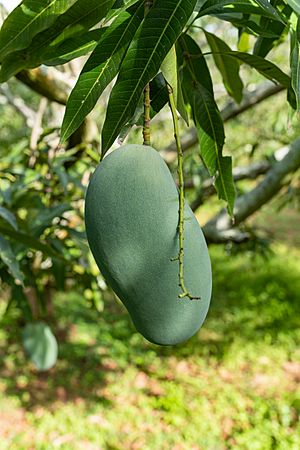Mallika (mango) facts for kids
Quick facts for kids Mangifera 'Mallika' |
|
|---|---|

'Mallika'
|
|
| Genus | Mangifera |
| Hybrid parentage | 'Neelum' x 'Dasheri' Mango |
| Cultivar | 'Mallika' |
| Origin | India |
The Mallika' mango is a special type of mango. It was created by mixing two other Indian mango kinds: the Neelum and the Dasheri mangoes. Dr. Ramnath Singh introduced this unique fruit. If you plant a 'Mallika' mango tree, it stays a good size. This makes it perfect for growing in your own backyard! You can usually pick its delicious fruit from June to July.
Contents
About the Fruit
Taste and Look
'Mallika' mangoes are known for being very high quality. They have no stringy fibers and are bright orange inside. The fruit tastes super sweet! You might notice flavors like citrus, melon, and honey when you eat one. People really liked the 'Mallika' mango at the Fairchild Botanic Gardens International Mango Festival.
Where They Grow Best
Mallika mangoes usually grow well in warm, tropical places. They also do fine in subtropical areas, which are a bit cooler but still warm most of the time.
Dealing with Cold Weather
If 'Mallika' mangoes are grown in colder temperatures, they might get a disease called malformation. This problem happens most often when mangoes grow in temperatures between 10 and 15 degrees Celsius. Luckily, it's not as common when temperatures are warmer than 15 degrees Celsius.
The malformation happens because cold weather makes the mango tree produce too much ethylene. Ethylene is a natural chemical that plants make when they are stressed. This stress can be from things like cold temperatures or even tiny pests.
Changes After Picking
After a 'Mallika' mango is picked, it starts to change. Three days after harvest, the skin turns a pretty reddish-yellow color. This happens because special colors called carotenoids increase, while green chlorophyll colors break down.
On the third day, the mango is also the most acidic and feels the firmest. But after that, it quickly becomes less acidic and softer. The mango becomes its heaviest on the fifth day after being picked. However, its size actually gets the smallest by the seventh day after harvest.

